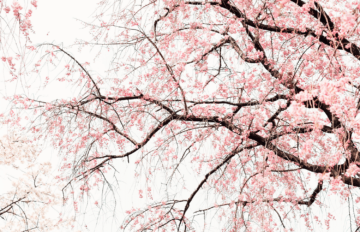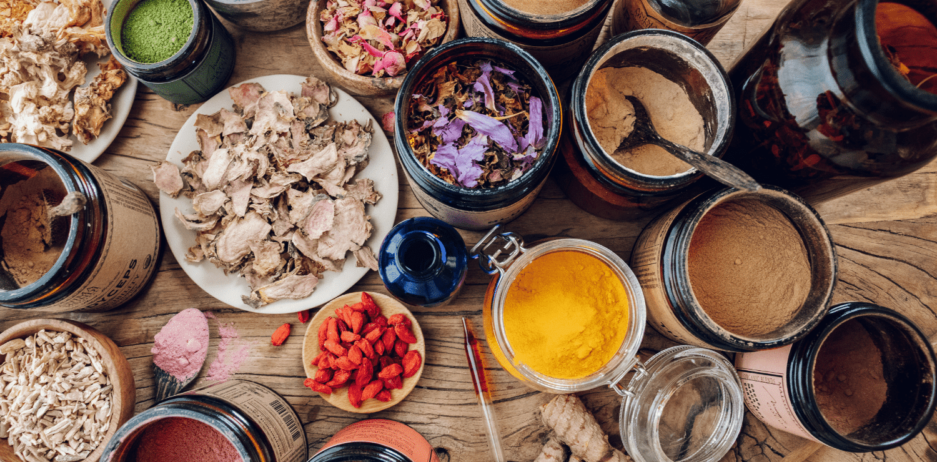
An introduction to adaptogens
These days the word stress is on everyone’s lips, the world in which we live is literally saturated with it, it has become the number one enemy of our well-being and contributes to maybe 75% of current illnesses.
None of us are immune to the stress of our modern life, with a backdrop of an urban environment, the constant noises of technology, the never ending to do list, the endless commitments and the way too short vacations. These psychological stressors associated with environmental stressors we are exposed to, such as pollution, chemicals, heavy metals, pesticides, cause increased oxidative damage in our bodies. In other words, our bodies are damaged by our constant state of stress.
To properly understand what are adaptogens, we first need to deepen our knowledge on what is stress. The notion of stress was introduced by the endocrinologist Hans Selye in 1925. He created the word stress to describe a sudden change in a person’s habits, capable of triggering an upheaval in their psychic and even somatic structure. He depicts an endocrine reaction syndrome with three consecutive phases: the “alarm phase”, the “reaction phase”, the “exhaustion phase”.
Stress can be considered as the stimulus that disrupt the homeostasis of our body. Homeostasis is the state of internal balance in our body, we are in this state when all of our physiological systems are in dynamic equilibrium which leads to optimal functioning.
What are adaptogens?
Adaptogens form a very special class of medicinal herbs that come from various parts of the world, used for centuries, especially in traditional Chinese medicine and Ayurveda, for their profound healing capacities.
Maybe you are already familiar with some of the popular ones and even consume some them: licorice, ginseng, goji berries, maca; some herbalists even consider rosemary and sage as potentially adaptogens.

In 1947 Dr. Nicolaï Lazarev defined an adaptogen as an agent that allows the body to counter adverse physical, chemical or biological stressors by raising nonspecific resistance towards such stress, allowing the organism to adapt to the stressful circumstances. At the end of the 60s, Dr. I. Breckhman and I. Dardymov formally gave adaptogens a functional definition, according to three specific criteria:
- An adaptogen is non-toxic to the recipient at normal therapeutic doses.
- An adaptogen produces a non-specific response in the bod, an increase in the power of resistance against multiple stressors including physical, chemical or biological agents.
- An adaptogen has normalizing effect on the body, helping to restore normal physiological function that has been altered by the stressor.
These herbs allow the body to better adapt to stressors in order to avoid damages.
They work “nonspecifically”, which means they target multiple functions of the body. The inherent intelligence of adaptogens also works by providing our body with what it particularly needs at a time. For example, if we are tired, adaptogens give us energy; if we are anxious, they have the ability to calm us. This is due to the impact that these plants have on our endocrine system, the HPA axis, which is made up of the hypothalamus, pituitary glands and adrenal glands. The HPA axis connects the central nervous and endocrine systems, it controls stress responses.
When a stressor occurs in our brain, the hypothalamus is activated. It acts as the command center of the stress response and signals through the sympathetic nervous system (SNS), pituitary glands and adrenal glands to start the production of the stress hormones, adrenaline and cortisol. A cascade of hormones in the body activates important physiological changes that act to keep the body alert, including increasing heart rate and blood pressure, oxygen intake and blood sugar levels, while suppressing the immune system, digestive system and reproductive system so that our body is ready to face stress / danger (the famous fight-flight response).
The system will self-regulate: when cortisol levels get high enough it signals to the brain to stop the response and the hormone levels will return to normal, restoring homeostasis. The heart rate is back to normal, the feeling of stress subsides, the body calms down and regains its normal balance.

But what if that sense of stress and urgency doesn’t go away? What if our body and mind are constantly in this alert phase, ready to face the next threat and release all of the stress hormones including adrenaline and cortisol? Long-term activation of the stress response system and overexposure to these types of hormones can disrupt almost all of our body’s processes, causing physical and mental exhaustion and leading to health problems. This results in chronic fatigue, weight gain, digestive problems, inflammation, a declining immune system, hormonal imbalances but also more serious pathologies.
Adaptogens will help reduce negative reactions during the alarm phase and allow us to stay in the resistance phase longer, via a stimulating effect that reduces or eliminates the exhaustion phase. Adaptogens will allow our body to adapt to stress so that it can resist its harmful effects. Adaptogens will strengthen the functioning of each of the body’s systems to promote an optimal response to stress, they will restore the natural balance (homeostasis) and help the proper functioning of the HPA axis. Adaptogens will increase the secretion of the adrenal glands, preventing excessive production of cortisol and adrenal fatigue.
Adaptogens can help regulate endocrine, nervous system, immune, digestive and cardiovascular function. This will therefore help increase stamina, energy, support and strengthen the immune system, and improve our ability to withstand physical and emotional stress, as well as increase recovery.
Some expert herbalists explain that based on the initial definition of adaptogens and the number of scientific studies, there are two categories of adaptogens. Primary adaptogens,that have been most extensively researched since the creation of the term adaptogens. Secondary adaptogens which have some characteristics of adaptogens (established by Dr I. Brekhman), but there has not been sufficient research to classify them as primary or official adaptogens. They can, however, enhance and synergize the effects of primary adaptogens.
There are 9 primary adaptogens: ginseng, ashwagandha, licorice, cordyceps, eleuthero, tulsi (holy basil), rhodiola, schisandra and shilajit.
The secondary adaptogens are: maca, mucuna, reishi, shatavari, astragalus, goji berry, amla, codonopsis (dang shen), bacopa (brahmi), he shou wu, jiaogulan (Gynostemma pentaphyllum)… in this category we also find many medicinal mushrooms such as: lion’s mane, chaga, maitake, turkey tail… and other herbs…
- There are 9 primary adaptogens: ginseng, ashwagandha, licorice, cordyceps, eleuthero, tulsi (holy basil), rhodiola, schisandra and shilajit.
- The secondary adaptogens are: maca, mucuna, reishi, shatavari, astragalus, goji berry, amla, codonopsis (dang shen), bacopa (brahmi), he shou wu,jiaogulan (Gynostemma pentaphyllum)… in this category we also find many medicinal mushrooms such as: lion’s mane, chaga, maitake, turkey tail… and other herbs…
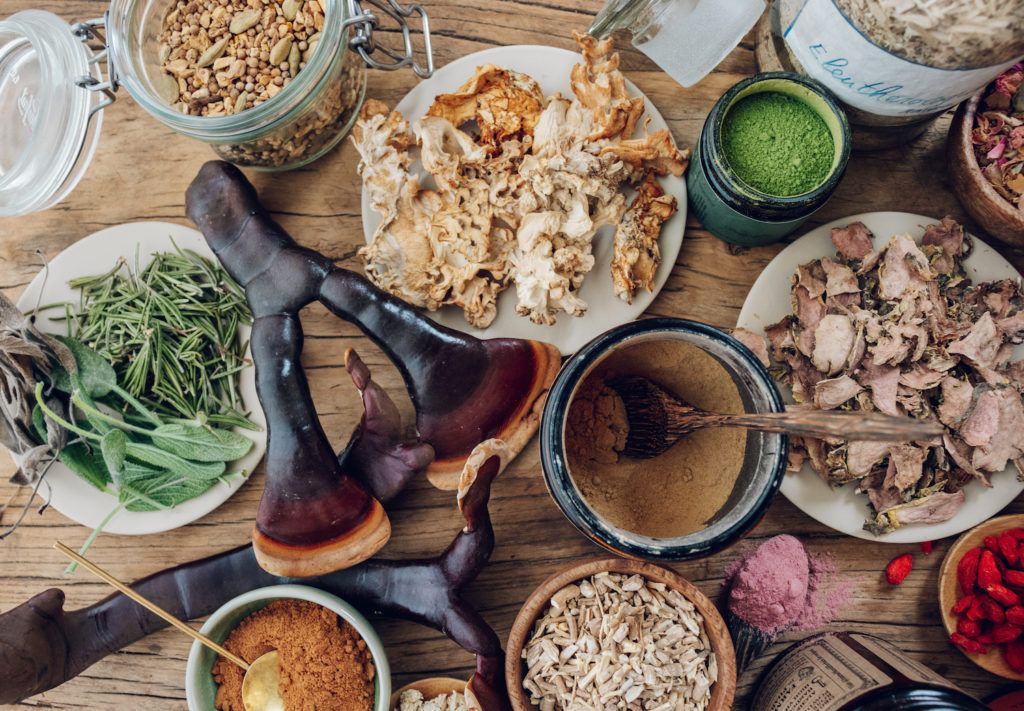
My experience with adaptogens
These plants have fascinated me for years, my first experience with adaptogens dates back to my very first trip to India in 2011. Ten years ago, the word “adaptogen” was unknown to my knowledge, as well as the many incomparable benefits of these herbs and did not have the popularity they now have in the wellness world. At the time I had decided to do the Ayurvedic treatment called panchakarma, during the cure the doctor of the Ayurvedic center seeing my enthusiasm for plant medicines, lent me two books: one on rasayanas, plants and minerals traditionally used in Ayurveda and the another on adaptogenic herbs. I read, learned, asked a whole bunch of questions and I returned to France with the books and bags filled with ashwagandha, amla, brahmi, holy basil, shatavari… it was the beginning of my personal learning.
Since this first trip, I returned to India in 2019 to follow a training course on the basics of Ayurveda, Ayurvedic nutrition and cooking, and Ayurvedic plant medicines.
Adaptogens in everyday life
For several years now I have been taking adaptogens daily, my favorites are ashwagandha, shatavari, cordyceps, reishi, tulsi and rhodiola rosea.
If you follow me on Instagram, you can see, that I often start my days with a blend of adaptogens that I add to my latte (cocoa, matcha or carob based). I mix in my blender between 2 to 3 adaptogen powders (1/2 to 1 teaspoon of each) with homemade nut milk (coconut, walnut, hemp, almond, cashew …) and hot water. I also add organic extra virgin coconut oil or other sources of good fats like seeds (sesame, sunflower …), coconut butter, flaxseed oil, chia seed oil, in order to extract all the benefits of the herbs. Take ashwagandha for example, in India, it is often prepared with ghee or coconut milk because the fats help its active ingredients to circulate in the body.
These herbs work very well as single herbs or in blends,I started with one adaptogens then I combined them together to create a synergistic effect (wider complementarity range of benefits).
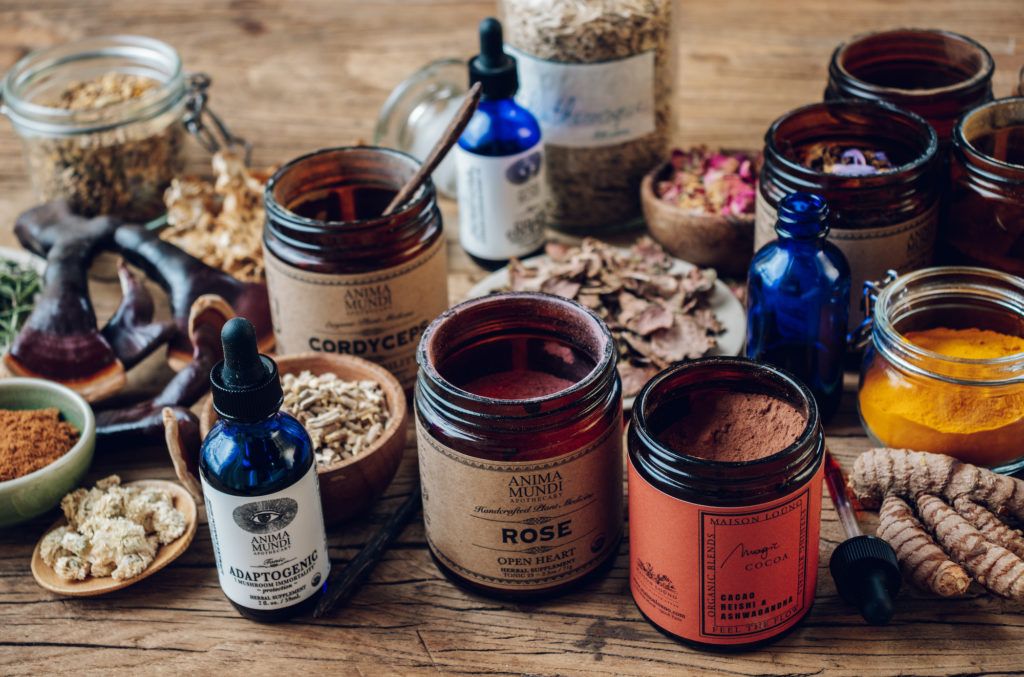
I often use a synergy of adaptogens like the Maison Louno rituals, a French brand that I really like, founded by French specialist Louise Skaudhauge. I use the Magic Cacao Morning Ritual which combines cacao, maca and cordyceps and the Magic Cacao Evening Ritual with cacao, ashwagandha and reishi, which I often prepare around 5-6 p.m. and which will soothe the end of my day. I also like the new blend that combines matcha, maca and lion’s mane, perfect in the morning or for a midday pick me up.
I also use products from Anima Mundi Herbals a brand founded by the inspiring herbalist Adriana Ayales, my favorites are reishi, cordyceps, mucuna, Adaptogenic and The Mind.
There are also liquid extract synergies of adaptogens called tincture, you can add drops to your favorite drink or directly under the tongue. I particularly like the tonics by Anima Mundi, I really like Happiness for Winter and the tinctures of medicinal mushrooms from Rainbo a brand founded by the amazing medicinal mushroom specialist Tonya Papanikolov, I looove the 11:11 blend.
I also often include adaptogens in my recipes: broths, soups, hummus, nut milks, morning porridge, homemade granola, smoothies, sorbets, homemade chocolates, energy balls …Don’t be afraid to get creative in the kitchen!
You can also find herbs directly in bulk at your favorite herbalist and make decoctions or infusions depending on the herbs.
Finally, it is also possible to take adaptogens in capsules (I like the French brand My Veggie for example) perfect for a daily treatment with a precise dosage and also practical when traveling.
My favorite adaptogens
For energy and stamina: Cordyceps, maca, rhodiola rosea, ginseng, astragalus, eleuthero, schisandra.
For emotional stress and anxiety: Ashwagandha, holy basil, rhodiola rosea, reishi.
For the immune system: Cordyceps, reishi, astragalus, eleuthero, lion’s mane.
For concentration and mental energy: Lion’s mane, astragalus, gotu kol.
How to choose and how to incorporate adaptogens into your routine
Although these herbs all have the adaptogenic characteristics mentioned earlier, each herb is different, unique and has its own benefits and actions.
Try to identify your needs or any imbalances you feel. Intuitively ask yourself what you want to improve. Do you want to increase your stamina? Be calmer in your daily life? Relieve your anxiousness? Do you need to be more focused?
To be able to notice the effects, I encourage you to start off with a small dose of one powder at a time so you can see the benefit on your body. Gently incorporate it into your daily routine. Also, it is important to remember that just because an adaptogen has worked well for your bestie does not mean that it will be beneficial for you.
Be patient, it may take several weeks before you to feel the benefits (except for some herbs which have a fairly immediate effect).
As any herbalist would tell you, it is always good to allow herbal remedies to ‘take their time’. Most of the time, the effects are seen between 2 weeks to a month, taken regularly, as a cure, so that you can really observe the effect of this adaptogen has on the body. It’s also good to take a break for a month a year and also to rotate the adaptogens in your routine every couple of months, switch adaptogens according to your needs.
I remember the very first time I started taking reishi, I took it daily in the morning in my matcha, this simple little ritual was so natural in my routine, that after a few weeks I totally forgot I was taking it, but then I started to notice a real improvement in my mood, my anxiety and my ability to deal with daily stress and suddenly I remembered: it’s the reishi, in full action!
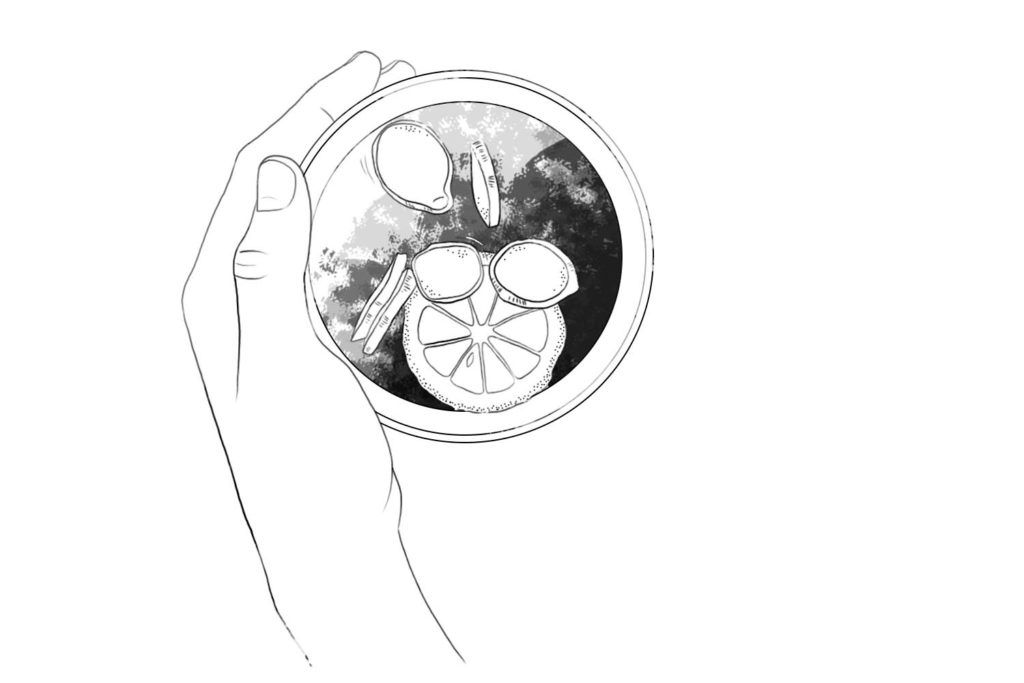
Then you can incorporate 2 to 3 adaptogens into your daily routine. If you don’t want to “play the little chemist” in the kitchen, you can also choose an adaptogen blend that meets your needs. A very simple advice: carefully read the labels on the packaging, the dosages are always indicated.
NB: For any medicinal herbs if you are pregnant or breastfeeding; if you are under medical treatment, or suffering from a serious illness, I advise you to consult your health care practitioner naturopath, qualified herbalist, phytotherapist, prior to use.
To conclude
Adaptogens deserve the growing fame they are undergoing since recent years, as plants able to strengthen our ability to manage stressors, maintain our well-being, optimize our health and vitality throughout our life.
I would like to conclude by saying that in order to protect your health and find balance, it is crucial to identify the cause of stress and it is essential to take care of yourself.
Your well-being must be supported by strong foundations: a wholesome diet that favors nourishing food, quality sleep, rest, movement, regardless of what type of exercise you choose, move, dance, stretch, also don’t forget to hydrate… and so many other elements which form a holistic approach to health. There are also other forms of complementary ways to manage stress such as spending time in nature, practicing yoga, meditation, breathing exercises, exploring your creativity, with painting, writing …
Remember, it’s good to find your own personal way to deal with stress effectively and once you’ve found that equation, try to apply it on a daily basis. And above all, don’t forget to be kind and patient with yourself, to take time for the people you love, the things that make you feel good and bring you joy, that matters a lot if you want to be less stressed and in good health!
Bibliography
- Adaptogens, David Winston & Steven Maimes
- Adaptogens, Adriana Ayales
- Adaptogens, Paula Grainger
- Ayurveda & Panchakarma, Sunil V.Joshi M.D.
- Super powders, Katrine Van Wyk
- Superherbs, Rachel Landon











